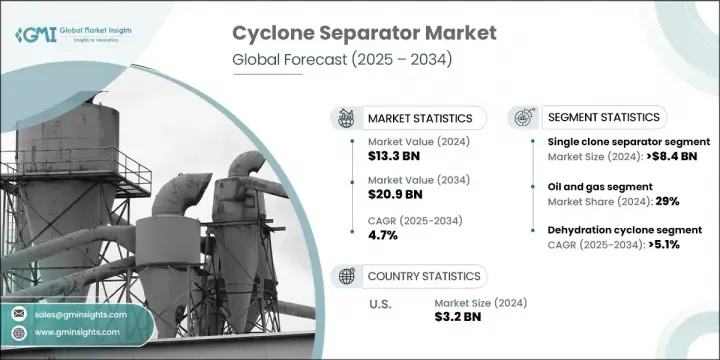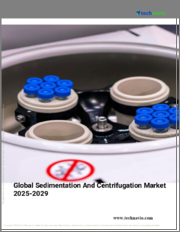
|
시장보고서
상품코드
1801904
사이클론 분리기 시장 : 기회, 성장 촉진요인, 산업 동향 분석, 예측(2025-2034년)Cyclone Separator Market Opportunity, Growth Drivers, Industry Trend Analysis, and Forecast 2025 - 2034 |
||||||
사이클론 분리기 세계 시장 규모는 2024년에 133억 달러로 평가되었고, CAGR 4.7%로 성장하고 2034년에는 209억 달러에 이를 것으로 예측됩니다.
이 시장은 청정 에너지 솔루션에 대한 증가와 세계의 엄격한 환경 규제로 견인력을 늘리고 있습니다. 바이오매스, 태양광 및 기타 대체 에너지원에 대한 수요가 증가함에 따라 배출을 줄이고 장비를 보호하기 위한 고성능 공기 여과 시스템에 대한 요구도 커지고 있습니다. 사이클론 분리기는 미립자를 처리하는 효율성에서 필수적인 솔루션으로 등장하여 여러 산업의 지속가능성 목표를 지원합니다.

다단 여과, CFD 최적화 설계, 하이브리드 시스템 등의 기술 발전으로 성능과 에너지 효율이 크게 향상되었습니다. 그 역할은 특히 화학, 일렉트로닉스, 제약과 같은 정밀 집약적인 분야에서 빠르게 진화하고 있습니다. 아시아태평양에서는 산업화가 급속히 진행되고 있는 국가들이 배출 규제 강화로 수요를 견인하고 있습니다. 사이클론 분리기는 인프라와 제조 활동의 확대에 대응하여 널리 채택되고 있습니다. 오늘날 경쟁 구도에서는 특히 업계가 장기적인 신뢰성과 낮은 유지 보수를 선호하기 때문에 제품 사용자 정의 및 재료 내구성과 같은 특징이 구매자의 의사 결정에 중요해지고 있습니다.
| 시장 범위 | |
|---|---|
| 시작 연도 | 2024년 |
| 예측 연도 | 2025-2034년 |
| 시작 금액 | 133억 달러 |
| 예측 금액 | 209억 달러 |
| CAGR | 4.7% |
싱글 사이클론 분리기는 2024년 84억 달러에 이르렀고, 2034년까지 연평균 복합 성장률(CAGR) 4.6%로 성장할 것으로 예측됩니다. 이 시스템이 널리 채택되는 이유는 초기 비용이 낮고 기계 구조가 간단하며 유지 보수가 필요하지 않기 때문입니다. 움직이는 부품이 없는 이러한 시스템은 지속적인 가동 시간과 예산 관리가 필수적인 환경에서 비용 효율적인 솔루션을 제공하며 운영 신뢰성을 요구하는 중공업에서 특히 매력적입니다.
석유 및 가스 부문은 2024년에 29%의 점유율을 차지하고 2025년부터 2034년에 걸쳐 CAGR 5.2%로 성장할 것으로 예측됩니다. 사이클론 분리기는 모래 떨어뜨림이나 액체와 기체의 분리 장치를 필요로 하는 업스트림 공정부터 가스 처리, 정제, 파이프라인 유지보수를 포함한 다운스트림 공정에 이르기까지 밸류 체인 전체에서 중요합니다. 이러한 분리기는 미립자 물질의 부하를 줄이고, 고가치의 기계를 보호하며, 고압 및 대량 환경에서의 운전을 중단시키지 않는 중요한 역할을 담당하고 있습니다.
미국 사이클론 분리기 시장은 2024년에 32억 달러를 창출하는 79%의 점유율을 차지합니다. 이 성장을 뒷받침하는 것은 고급 대기 품질 관리 솔루션을 필요로 하는 엄격한 환경 정책입니다. 규제로 산업계는 효율적인 미립자 제거 기술의 도입을 강요하고 있습니다. 사이클론 분리기는 일반적으로 전 여과 도구로 사용되며 최종 여과 시스템의 부담을 효과적으로 줄이고 규제 준수를 보장하며 전반적인 운영 효율성을 최적화합니다.
사이클론 분리기 시장을 적극적으로 형성하는 주요 기업으로는 Micropor, Sulzer, FLSmidth, Gulf Coast Air & Hydraulics, Cyclone Engineering Projects, Multotec, The Weir Group, KREBS, Exterran Corporation, Air Dynamics, Cyclotech, Haiwang 솔루션, 사이클론 분리기 Australia 등이 있습니다. 사이클론 분리기 시장의 주요 제조업체는 경쟁력을 강화하기 위해 전략적 제품 혁신과 지역 확대에 주력하고 있습니다. CFD와 같은 첨단 시뮬레이션 툴을 도입하고 분리기 설계를 최적화함으로써 보다 높은 효율과 낮은 에너지 소비를 실현하는 기업이 늘고 있습니다. 또한 제약, 일렉트로닉스, 클린 에너지 등의 고정밀 산업에 대응하기 위한 제품의 다양화도 진행되고 있습니다. 각 제조업체는 산업 고객과 파트너십을 맺고 엄격한 배출 및 운영 기준을 충족하는 맞춤형 솔루션을 제공합니다. 많은 기업들은 특히 아시아태평양 신흥 시장에 대응하기 위해 세계적인 제조 및 판매 네트워크를 확대하고 있습니다.
목차
제1장 조사 방법과 범위
제2장 주요 요약
제3장 업계 인사이트
- 생태계 분석
- 공급자의 상황
- 이익률
- 각 단계에서의 부가가치
- 밸류체인에 영향을 주는 요인
- 업계에 미치는 영향요인
- 성장 촉진요인
- 업계의 잠재적 위험 및 과제
- 기회
- 성장 가능성 분석
- 장래 시장 동향
- 기술과 혁신의 상황
- 현재의 기술 동향
- 신흥기술
- 가격 동향
- 지역별
- 유형별
- 규제 상황
- 표준 및 컴플라이언스 요건
- 지역 규제 틀
- 인증기준
- Porter's Five Forces 분석
- PESTEL 분석
제4장 경쟁 구도
- 소개
- 기업의 시장 점유율 분석
- 지역별
- 기업 매트릭스 분석
- 주요 시장 기업의 경쟁 분석
- 경쟁 포지셔닝 매트릭스
- 주요 발전
- 합병과 인수
- 파트너십 및 협업
- 신제품 발매
- 확장 계획
제5장 시장 추정 및 예측 : 유형별, 2021년-2034년
- 주요 동향
- 축류
- 역류
제6장 시장 추정 및 예측 : 클론 유형별, 2021년-2034년
- 주요 동향
- 단일 클론 분리기
- 멀티 클론 분리기
제7장 시장 추정 및 예측 : 용량별, 2021년-2034년
- 주요 동향
- Up to 2000 kg/hr
- 2000kg/hr - 3000kg/hr
- Above 3000 kg/hr
제8장 시장 추정 및 예측 : 용도별, 2021년-2034년
- 주요 동향
- 탈수 사이클론
- 탈진 사이클론
- 슬래그 제거 사이클론
- 기타(집중 사이클론, 사이클론군 등)
제9장 시장 추정 및 예측 : 최종 이용 산업별, 2021년-2034년
- 주요 동향
- 석유 및 가스
- 화학약품
- 광업 및 광물 처리
- 발전
- 식음료
- 기타(펄프 및 종이, 섬유, 의약품 등)
제10장 시장 추정 및 예측 : 유통 채널별, 2021년-2034년
- 주요 동향
- 직접 판매
- 간접판매
제11장 시장 추정 및 예측 : 지역별, 2021년-2034년
- 주요 동향
- 북미
- 미국
- 캐나다
- 유럽
- 독일
- 영국
- 프랑스
- 스페인
- 이탈리아
- 네덜란드
- 아시아태평양
- 중국
- 일본
- 인도
- 호주
- 한국
- 라틴아메리카
- 브라질
- 멕시코
- 아르헨티나
- 중동 및 아프리카
- 남아프리카
- 사우디아라비아
- 아랍에미리트(UAE)
제12장 기업 프로파일
- Air Dynamics
- Cyclone Engineering Projects
- Cyclone Separator Australia
- Cyclotech
- Elgin Separation Solutions
- Exterran Corporation
- FLSmidth
- Gulf Coast Air & Hydraulics
- Haiwang Hydrocyclone
- KREBS
- Mahle Industrial Filtration
- Mikropor
- Multotec
- Sulzer
- The Weir Group
The Global Cyclone Separator Market was valued at USD 13.3 billion in 2024 and is estimated to grow at a CAGR of 4.7% to reach USD 20.9 billion by 2034. The market is gaining traction due to the increasing push toward clean energy solutions and stringent global environmental regulations. As the demand for biomass, solar, and other alternative energy sources increases, so does the requirement for high-performance air filtration systems to reduce emissions and protect equipment. Cyclone separators have emerged as vital solutions due to their efficiency in handling particulates, supporting sustainability goals across multiple industries.

Technological advancements such as multi-stage filtration, CFD-optimized designs, and hybrid systems have significantly improved performance and energy efficiency. Their role is rapidly evolving, especially in precision-intensive sectors like chemicals, electronics, and pharmaceuticals. In the Asia-Pacific region, countries experiencing fast industrialization are driving demand due to tighter emission regulations. Cyclone separators are being widely adopted in response to growing infrastructure and manufacturing activity. In today's competitive landscape, features such as product customization and material durability are becoming critical for buyer decision-making, especially as industries prioritize long-term reliability and low maintenance.
| Market Scope | |
|---|---|
| Start Year | 2024 |
| Forecast Year | 2025-2034 |
| Start Value | $13.3 Billion |
| Forecast Value | $20.9 Billion |
| CAGR | 4.7% |
Single cyclone separators reached USD 8.4 billion in 2024 and is anticipated to grow at a CAGR of 4.6% through 2034. Their widespread adoption is attributed to low upfront costs, simple mechanical structure, and minimal maintenance requirements. With no moving parts, these systems offer a cost-efficient solution in environments where continuous uptime and budget control are essential, making them especially appealing in heavy industries seeking operational reliability.
The oil & gas sector held a 29% share in 2024 and is set to grow at a CAGR of 5.2% between 2025 and 2034. Cyclone separators are critical throughout the entire value chain-from upstream operations requiring devices for desanding and liquid-gas separation to downstream applications involving gas processing, refining, and pipeline maintenance. These separators play a crucial role in reducing particulate load, safeguarding high-value machinery, and ensuring uninterrupted operations in high-pressure, high-volume environments.
United States Cyclone Separator Market held a 79% share generating USD 3.2 billion in 2024. This growth is fueled by strict environmental policies requiring advanced air quality management solutions. Regulations compel industries to deploy efficient particulate removal technologies. Cyclone separators are commonly used as pre-filtration tools, effectively decreasing the burden on final filtration systems, ensuring regulatory compliance, and optimizing overall operational efficiency.
Key players actively shaping the Cyclone Separator Market include Mikropor, Sulzer, FLSmidth, Gulf Coast Air & Hydraulics, Cyclone Engineering Projects, Multotec, The Weir Group, KREBS, Exterran Corporation, Air Dynamics, Cyclotech, Haiwang Hydrocyclone, Mahle Industrial Filtration, Elgin Separation Solutions, and Cyclone Separator Australia. Leading manufacturers in the cyclone separator market are focusing on strategic product innovation and regional expansion to strengthen their competitive positions. Companies are increasingly integrating advanced simulation tools like CFD to optimize separator designs for greater efficiency and lower energy consumption. Product diversification to serve high-precision industries such as pharmaceuticals, electronics, and clean energy is also on the rise. Players are forming partnerships with industrial clients to deliver tailored solutions that meet strict emission and operational standards. Many firms are expanding their global manufacturing and distribution networks to serve emerging markets, especially in Asia-Pacific.
Table of Contents
Chapter 1 Methodology and scope
- 1.1 Market scope and definition
- 1.2 Research design
- 1.2.1 Research approach
- 1.2.2 Data collection methods
- 1.3 Data mining sources
- 1.3.1 Global
- 1.3.2 Regional/country
- 1.4 Base estimates and calculations
- 1.4.1 Base year calculation
- 1.4.2 Key trends for market estimation
- 1.5 Primary research and validation
- 1.5.1 Primary sources
- 1.6 Forecast model
- 1.7 Research assumptions and limitations
Chapter 2 Executive summary
- 2.1 Industry 3600 synopsis
- 2.2 Key market trends
- 2.2.1 Regional
- 2.2.2 By type
- 2.2.3 By clone type
- 2.2.4 By capacity
- 2.2.5 By application
- 2.2.6 By end use industry
- 2.2.7 By distribution channel
- 2.3 CXO perspectives: strategic imperatives
- 2.3.1 Key decision points for industry executives
- 2.3.2 Critical success factors for market players
- 2.4 Future outlook and strategic recommendations
Chapter 3 Industry insights
- 3.1 Industry ecosystem analysis
- 3.1.1 Supplier landscape
- 3.1.2 Profit margin
- 3.1.3 Value addition at each stage
- 3.1.4 Factor affecting the value chain
- 3.2 Industry impact forces
- 3.2.1 Growth drivers
- 3.2.2 Industry pitfalls & challenges
- 3.2.3 Opportunities
- 3.3 Growth potential analysis
- 3.4 Future market trends
- 3.5 Technology and innovation landscape
- 3.5.1 Current technological trends
- 3.5.2 Emerging technologies
- 3.6 Price trends
- 3.6.1 By region
- 3.6.2 By type
- 3.7 Regulatory landscape
- 3.7.1 Standards and compliance requirements
- 3.7.2 Regional regulatory frameworks
- 3.7.3 Certification standards
- 3.8 Porter’s analysis
- 3.9 PESTEL analysis
Chapter 4 Competitive landscape, 2024
- 4.1 Introduction
- 4.2 Company market share analysis
- 4.2.1 By region
- 4.2.1.1 North America
- 4.2.1.2 Europe
- 4.2.1.3 Asia Pacific
- 4.2.1.4 Latin America
- 4.2.1.5 MEA
- 4.2.1 By region
- 4.3 Company matrix analysis
- 4.4 Competitive analysis of major market players
- 4.5 Competitive positioning matrix
- 4.6 Key developments
- 4.6.1 Mergers & acquisitions
- 4.6.2 Partnerships & collaborations
- 4.6.3 New product launches
- 4.6.4 Expansion plans
Chapter 5 Market Estimates & Forecast, By Type, 2021 - 2034 ($Billion, Thousand Units)
- 5.1 Key trends
- 5.2 Axial flow
- 5.3 Reverse flow
Chapter 6 Market Estimates & Forecast, By Clone type, 2021 - 2034 ($Billion, Thousand Units)
- 6.1 Key trends
- 6.2 Single clone separator
- 6.3 Multi-clone separator
Chapter 7 Market Estimates & Forecast, By Capacity, 2021 - 2034 ($Billion, Thousand Units)
- 7.1 Key trends
- 7.2 Up to 2000 kg/hr
- 7.3 2000 kg/hr. - 3000 kg/hr
- 7.4 Above 3000 kg/hr
Chapter 8 Market Estimates & Forecast, By Application, 2021 - 2034 ($Billion, Thousand Units)
- 8.1 Key trends
- 8.2 Dehydration cyclone
- 8.3 Desliming cyclone
- 8.4 Slag removal cyclones
- 8.5 Others (concentration cyclone, cyclone group etc.)
Chapter 9 Market Estimates & Forecast, By End Use Industry, 2021 - 2034 ($Billion, Thousand Units)
- 9.1 Key trends
- 9.2 Oil and gas
- 9.3 Chemical
- 9.4 Mining and mineral processing
- 9.5 Power generation
- 9.6 Food and beverages
- 9.7 Others (pulp & paper, textiles, pharmaceutical etc.)
Chapter 10 Market Estimates & Forecast, By Distribution Channel, 2021 - 2034 ($Billion, Thousand Units)
- 10.1 Key trends
- 10.2 Direct sales
- 10.3 Indirect sales
Chapter 11 Market Estimates & Forecast, By Region, 2021 - 2034 ($Billion, Thousand Units)
- 11.1 Key trends
- 11.2 North America
- 11.2.1 U.S.
- 11.2.2 Canada
- 11.3 Europe
- 11.3.1 Germany
- 11.3.2 UK
- 11.3.3 France
- 11.3.4 Spain
- 11.3.5 Italy
- 11.3.6 Netherlands
- 11.4 Asia Pacific
- 11.4.1 China
- 11.4.2 Japan
- 11.4.3 India
- 11.4.4 Australia
- 11.4.5 South Korea
- 11.5 Latin America
- 11.5.1 Brazil
- 11.5.2 Mexico
- 11.5.3 Argentina
- 11.6 MEA
- 11.6.1 South Africa
- 11.6.2 Saudi Arabia
- 11.6.3 UAE
Chapter 12 Company Profiles
- 12.1 Air Dynamics
- 12.2 Cyclone Engineering Projects
- 12.3 Cyclone Separator Australia
- 12.4 Cyclotech
- 12.5 Elgin Separation Solutions
- 12.6 Exterran Corporation
- 12.7 FLSmidth
- 12.8 Gulf Coast Air & Hydraulics
- 12.9 Haiwang Hydrocyclone
- 12.10 KREBS
- 12.11 Mahle Industrial Filtration
- 12.12 Mikropor
- 12.13 Multotec
- 12.14 Sulzer
- 12.15 The Weir Group



















